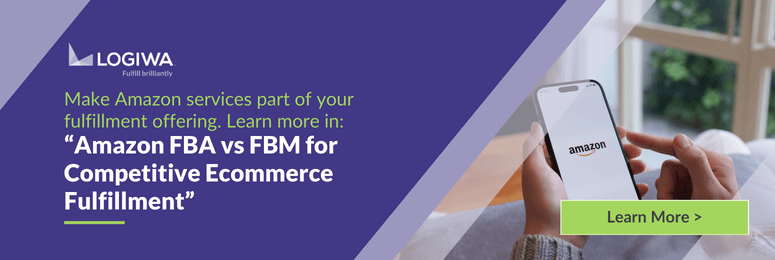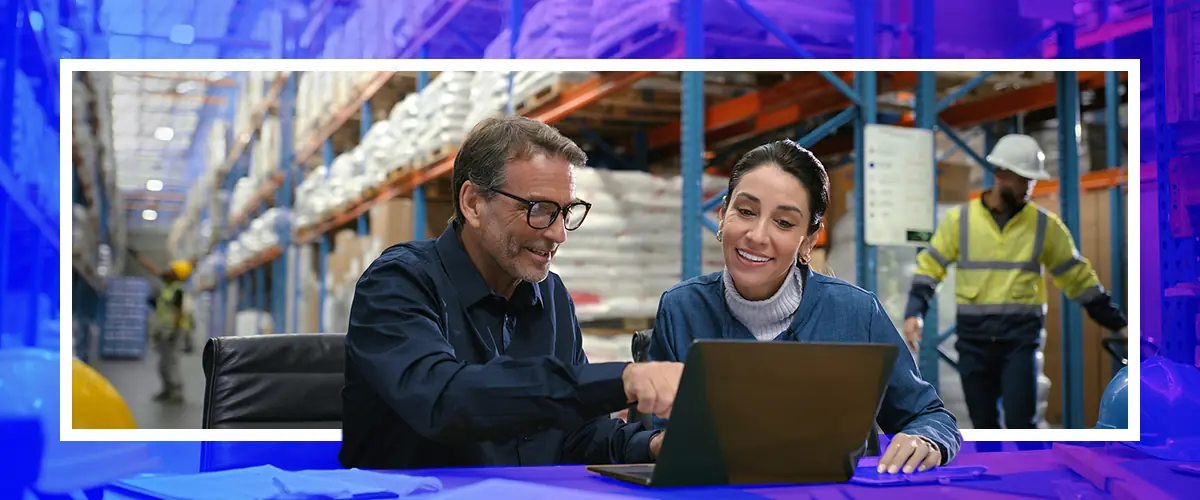From lightning-fast delivery times to impeccable inventory management, competing with Amazon standards requires strategic technology and the ability to optimize efficiency. This blog will cover some key ways to help your business rise to the challenge.
Key Takeaways
- Amazon continues to lead the logistics market, owning 40% of all global ecommerce sales.
- Consumers expect fulfillment operations to meet Amazon standards, which includes speedy deliveries, easy returns, real-time order tracking, and free shipping.
- In order to compete with Amazon, businesses must leverage AI and cutting-edge technologies to optimize fulfillment processes and delivery results.
- Strategies like smart automation and predictive analytics fine-tune inventory and order management, thereby creating a competitive advantage.
- Continuous innovation is key to remaining dynamic, adaptable, and on-par with Amazon.
Contents
The Amazon Standard: Setting the Bar for Logistics
As of 2023, Amazon has at least 310 million active customer accounts around the world. It also holds the largest portion of ecommerce sales (nearly 40%) of any online retailer. This not only allows them to set the standard for modern fulfillment, but push the limits of what is expected of logistics operations by consumers.
Amazon continues to invest in groundbreaking fulfillment technology as it redefines the logistics landscape. This has led to the benchmark commonly known as “the Amazon standard.” This standard encompasses several key aspects that pose both challenges and opportunities for direct-to-consumer (DTC) operations:
Same-Day and Next-Day Shipping
Amazon’s most noticeable impact on logistics standards is in its delivery speed. With options for same-day and next-day shipping, Amazon has set consumer expectations incredibly high. This rapid turnaround time pressures DTC operations to optimize their logistics to keep pace. For many, this means re-evaluating shipping strategies, distribution center locations, and carrier partnerships to shorten delivery times without significantly increasing costs.
Effortless Returns
Another cornerstone of the Amazon standard is its hassle-free return policy. Amazon’s easy and free return process has become a benchmark for customer service, pushing DTC businesses to streamline return processes. This requires efficient reverse logistics systems and a customer-friendly approach to returns, which can be challenging from both a logistical and a financial perspective.
Real-Time Order Tracking
Transparent order fulfillment, enabled by real-time order tracking, is a feature customers have come to expect, thanks in part to Amazon. DTC operations must integrate advanced tracking systems to provide customers with up-to-date information about their orders. This often involves significant investment in technology and systems integration to ensure real-time communication and visibility.
Free Shipping
The expectation of free shipping, popularized by Amazon, especially for its Prime members, has become a norm in online retail. This presents a challenge for DTC operations as they balance customer expectations with the financial implications of offering free shipping. Many businesses are exploring solutions such as minimum order thresholds to make this financially viable.
For DTC operations, meeting the Amazon standard is a multifaceted challenge. It requires a careful balance between customer expectations and operational feasibility. However, whether you are a major brand, retailer, online seller, or third-party logistics (3PL) operations—you will achieve greater success if you can meet these standards.
15 Ways to Achieve Amazon-Like Logistics
Investing in technology and infrastructure, optimizing your supply chains, and continually innovating are key to meeting the standards set by Amazon. Here are 15 ways to help your operations achieve Amazon-level results:
1. Embracing Cloud-Native Fulfillment Solutions
Amazon’s agility in logistics is partly due to its robust Cloud infrastructure. DTC operations should consider adopting Cloud-native Fulfillment Management Systems (FMS) in order to keep up. These systems offer scalability, real-time data access, and easy integration to ecommerce platforms, warehouses, and shippers. With a Cloud-native FMS, you can streamline your fulfillment process and be that much closer to achieving Amazon-level flexibility and efficiency.
2. Utilizing AI-Driven Warehouse Technology
AI technology reduces errors, saves time, and boosts efficiency. It enhances operations through smart picking and walking path optimization to help you match Amazon’s logistics in your facilities. AI can also aid demand forecasting for improved inventory management and streamlined order fulfillment.
With AI-powered solutions like Logiwa IO, you can increase productivity by 38% and improve task completion by 58%.
Unlock a personalized tour of Logiwa IO
3. Leveraging Predictive Data Analytics
Data makes up the heart of Amazon’s operational efficiency. You should be harnessing the power of data analytics and predictive logistics as well. By analyzing past trends, customer behaviors, and real-time operational data, you can anticipate changes in demand, manage inventory more effectively, and optimize your fulfillment strategies.
4. Prioritizing Speed and Efficiency in Fulfillment
Amazon’s rapid delivery and accuracy have set new consumer expectations. To keep up, aim for same-day or next-day shipping. Streamline your warehouse layout and automate picking and packing. Ensure your ecommerce channels, fulfillment network, and shipping partners work seamlessly together. Use barcoding, mobile scanning, and AI-driven tasks, along with robotics, to quicken operations and enhance accuracy.
5. Enhancing Customer Experience with Real-Time Tracking
One of Amazon’s strong suits is its customer-centric approach, particularly in providing real-time order tracking. Your operations should implement technologies that enable customers to track the status of orders in real-time. This enhances transparency and improves customer satisfaction.
6. Exploring Collaborative Robots (Cobots) for Warehouse Operations
Amazon’s use of robotics in its warehouses sets a precedent for efficiency. DTC operations can explore the use of collaborative robots (cobots) to assist human workers in repetitive and physically demanding tasks, thereby increasing efficiency and reducing the likelihood of errors and injuries.
7. Adopting Headless and Serverless Architecture
Innovative architectural approaches like headless and serverless systems offer unmatched flexibility and customization. These technologies allow your DTC operations to adapt swiftly to market changes and scale logistics operations without significant infrastructure changes.
FMS like Logiwa IO are both headless and serverless to ensure you can tailor the solution to meet your unique workflow and customer requirements.
8. Fostering a Dynamic Partner Ecosystem
Building a network of strategic partnerships is vital to competing with Amazon. By collaborating with various partners, your operations can extend its reach, share resources, and tap into specialized expertise. This helps effectively enhance your logistics and fulfillment approach.
Logiwa’s Partner Marketplace is a prime example of this. It makes it easy to add integrations, tools, and modules—ensuring ongoing innovation and limitless configurability.
9. Investing in Sustainable and Eco-Friendly Logistics Practices
Sustainability is becoming increasingly important to gaining and retaining customers. Your operation should invest in eco-friendly logistics practices, such as optimizing delivery routes for reduced emissions and using sustainable packaging. This approach not only resonates with environmentally conscious consumers but can also lead to streamlined operations.
10. Enhancing Labor Efficiency and Reducing Turnover
High labor turnover is a significant challenge across the logistics industry. This makes it increasingly important to adopt strategies that enhance labor efficiency and happiness. For example, you can provide valuable training, user-friendly software, and assistive technologies to create a positive work environment.
Tools like Logiwa IO, which offer intuitive interfaces and efficient workflows, can significantly reduce the learning curve for new employees. This helps lover turnover rates and makes it easy to get new or temporary seasonal workers up-to-speed without hassle.
11. Implementing Smart Storage Solutions
Smart storage solutions, such as automated storage and retrieval systems (AS/RS), can significantly enhance warehouse operations’ efficiency. These systems allow for quicker retrieval times and better space utilization. As a result, you can help your operations handle higher volumes of orders more effectively.
12. Focusing on Omni-Channel Fulfillment
Amazon’s success is partly due to its strong omni-channel presence. As a DTC operation, you must focus on integrating online and offline channels to provide a seamless customer experience. This includes ensuring inventory visibility across all channels and offering flexible delivery and return options.
13. Customization and Personalization in Fulfillment
One area where you can outshine Amazon is by offering customized and personalized services. This can range from personalized packaging to tailored delivery options, adding a unique touch that large-scale operations like Amazon may not provide. Features like rate shopping can help you achieve cost-savings and the ability to offer free shipping.
14. Strengthening Last-Mile Delivery Capabilities
The last-mile delivery is critical in the customer’s overall experience. Your operations should focus on having a strong last-mile delivery strategy. This can include securing partnerships with local delivery services, investing in your own fleet, and ensuring shipments are optimized and leave on-time.
15. Continuous Innovation and Adaptation
Competing with Amazon lies in continuous innovation. Your operations must stay ahead of the latest trends and technologies in logistics. This includes being ready and able to adapt at a moment’s notice. Embracing a culture of innovation will enable your business to remain agile and responsive to changing market dynamics.
While Amazon sets a high standard in logistics, there are numerous ways for your operation to compete effectively. By embracing technological advancements, focusing on customer experience, and continuously innovating, your business can not only keep up but also carve out its own space in the competitive world of logistics and fulfillment.
Achieve the Amazon Standard with Logiwa IO
Outpacing the Amazon standard may seem daunting, but it’s within reach with the right tools and strategies. Logiwa IO stands as your ally in this journey, offering the capabilities you need to elevate your fulfillment game.
- Cloud-native, serverless, headless, and versionless architecture
- AI-driven fulfillment features for high-efficiency operations
- Intuitive UI/UX modeled after social media
- Partner Marketplace for self-serve integrations, add-ons, and modules
- Rapid deployment and implementation with accelerated time to value
Don’t just compete with Amazon; set your own benchmarks for success. Discover the power of Logiwa IO and redefine what’s possible for your high-volume fulfillment operations.
FAQs on Competing with Amazon Fulfillment Logistics
What is “the Amazon standard?”
The Amazon standard refers to the high benchmark set by Amazon in ecommerce logistics. It encompasses rapid delivery (including same-day and next-day shipping), efficient and user-friendly return policies, advanced warehouse automation, real-time order tracking, and exceptional customer service.
How does “the Amazon standard” affect modern ecommerce and fulfillment operations?
For modern fulfillment operations, meeting this standard means adapting to these elevated consumer expectations. It involves investing in technology, streamlining operations, and ensuring a seamless, efficient, and customer-centric fulfillment process. Essentially, it’s about providing a fast, reliable, and hassle-free shopping experience that rivals Amazon’s.
Is it possible to compete with Amazon?
Absolutely. Competing with Amazon is challenging but feasible, especially when businesses leverage the right strategies and technologies. While Amazon has set a high bar in logistics and customer service, you can find niches where you can excel or embrace advanced technologies to create a competitive edge.
How can you compete with Amazon fulfillment logistics?
To compete with Amazon’s fulfillment logistics, it’s crucial to integrate advanced technologies like AI-driven warehouse management and cloud-native systems, like Logiwa IO, for optimized operations. Enhancing speed, efficiency, customer experience, and sustainable practices, along with continuous innovation, are key strategies.
Unlock High-Volume Fulfillment Success with AI as Your Guide.
Warehouse Management
Modern digital WMS powers a modern fulfillment experience






